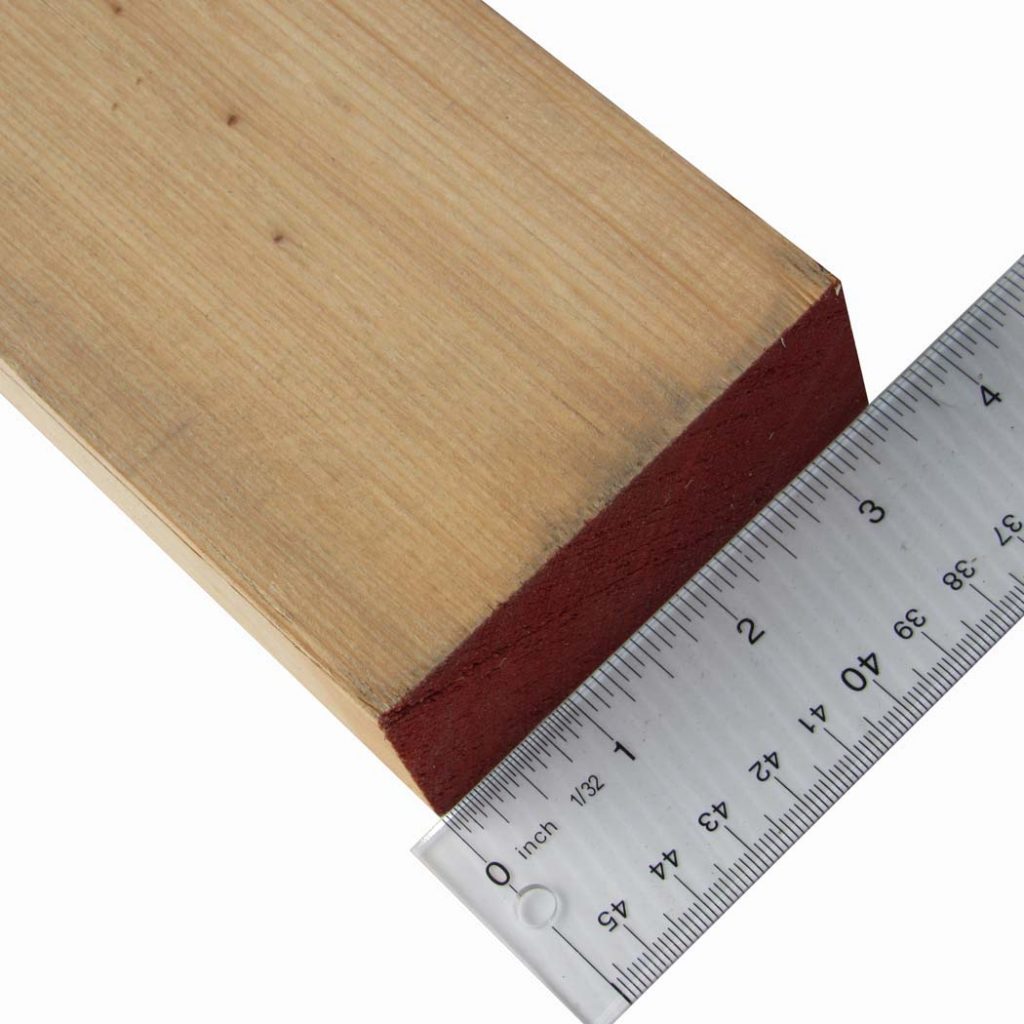Lumber isn’t the only option for construction these days, but it is still the most versatile and durable choice. Nothing can compare to dimensional lumber. Dimensional lumber is a type of wood product that is commonly used in construction because of its strength and ability to support heavy loads. When working with lumber dimensions, you use nominal and actual dimensions. The difference between the two can be a point of confusion with the average consumer who doesn’t work with wood regularly.
Usually, when buying lumber, whether it is hardwood lumber or softwood lumber, you need to look at the thickness as well as the width and length of the board. In this article, we explain the difference between nominal and actual lumber dimensions.

What Is Dimensional Lumber?
Dimensional lumber is a wood fiber that is cut to a specific thickness, width, and length based on predefined and standardized sizes. Some examples of lumber dimensions include 2 x 4s and 4 x 4s. You should also understand the different measurements for hardwood and softwood.
Hardwood Lumber
Hardwood lumber is timber derived from trees that are deciduous and have broad leaves that fall off over the cold months. Hardwood commonly comes from hickory, walnut, oak, maple, and mahogany. These are extremely durable and can withstand harsh weather conditions. You can be confident when using hardwood dimensional lumber on building projects that your structure will stand up and meet the tests of time. Lumber made from hardwood trees is naturally resistant to pests and decay. Except for balsa wood, hardwoods are not easily dented and are harder than softwoods. This type of lumber is more expensive than softwood lumber because it takes a longer time to mature.
Softwood Lumber
Softwood lumber (timber) comes from conifer trees such as cedar, fir, spruce, and pine. This type of lumber can be easily dented and bowed with light pressure. It absorbs and loses moisture faster and easier than hardwoods, generally making it necessary to provide extra care to remain beautiful. When it is pressure-treated, softwood lumber can hold up against the elements. Softwood is far cheaper than hardwood and is often used in construction. For more information on the best wood for outdoor use, check out our blog.
Nominal vs Actual Sizing for Dimensional Lumber Sizes
Dimensional lumber sizes can be confusing since there is a difference between the nominal and actual dimensions of the lumber. Primarily, differentiation comes into play regarding the thickness and width of a board. Nominal sizing refers to the board’s size when it was first rough cut and before it has been planed (smoothed) on all sides. Wood shrinks as it dries and the planing or surfacing process removes some of the original material. This means that the wood’s actual size measurements are different from the nominal measurements. When you are working on a project that requires specific measurements, it’s important to check the actual size and actual measurements and actual lumber sizes for your work before purchasing the lumber.
Understanding and Identifying Dimensions
Dimensional lumber has typical nominal dimensions for wood, such as a two by four (2 x 4), which refers to the thickness and the width of the wood. When a third number is added to the nominal dimensions, such as 2 x 4 x 96, it indicates the length of the board. Softwoods have nominal size dimensions that include the thickness and the width. Hardwoods, on the other hand, may only include thickness. Hardwoods can also be surfaced on one side only (S1S) or on two sides (S2S), which further affects the board dimension. And, additionally, hardwoods are sold by the volume unit called a board foot rather than board dimension. A board foot is calculated by multiplying the nominal thickness, width, and length of the cuts of wood.
How to Determine Actual Lumber Dimensions
When calculating nominal and actual lumber dimensions, there is a simple rule you can use to determine the actual dimensions of your lumber vs. nominal lumber sizes:
- For lumber with a nominal size smaller than 1″, subtract 1/4″.
- For lumber with a nominal size larger than 2″ but smaller than 8″, subtract 1/2″.
- For lumber with a nominal size of 8″ or larger, subtract 3/4″.
Softwood – Nominal vs Actual Lumber Sizes
Softwood lumber such as pine, cedar, fir, and spruce is commonly used for the construction and finishing of walls and floors. In the United States, the National Institute of Standards governs softwood lumber standards through the American Softwood Lumber Standard (PS 20).
North American Standard 1-by Lumber
| Nominal Size | Actual Size (inches) | Actual Size (mm) |
|---|---|---|
| 1×2″ | 3/4 x 1-1/2″ | 19 x 38 |
| 1×3″ | 3/4 x 2-1/2″ | 19 x 64 |
| 1×4″ | 3/4 x 3-1/2″ | 19 x 89 |
| 1×6″ | 3/4 x 5-1/2″ | 19 x 140 |
| 1×8″ | 3/4 x 7-1/4″ | 19 x 184 |
| 1×10″ | 3/4 x 9-1/4″ | 19 x 235 |
| 1×12″ | 3/4 x 11-1/4″ | 19 x 286 |
North American Standard 2-by Lumber
| Nominal Size | Actual Size (inches) | Actual Size (mm) |
|---|---|---|
| 2×2″ | 1-1/2 x 1-1/2 | 38 x 38 |
| 2×3″ | 1-1/2 x 2-1/2 | 38 x 64 |
| 2×4″ | 1-1/2 x 3-1/2 | 38 x 89 |
| 2×6″ | 1-1/2 x 5-1/2 | 38 x 140 |
| 2×8″ | 1-1/2 x 7-1/4 | 38 x 184 |
| 2×10″ | 1-1/2 x 9-1/4 | 38 x 235 |
| 2×12″ | 1-1/2 x 11-1/4 | 38 x 286 |
North American Standard 4-by Lumber
| Nominal Size | Actual Size (inches) | Actual Size (mm) |
|---|---|---|
| 4×4″ | 3-1/2 x 3-1/2″ | 89 x 89 |
| 4×6″ | 3-1/2 x 5-1/2″ | 89 x 140 |
| 4×8″ | 3-1/2 x 7-1/4″ | 89 x 184 |
| 4×10″ | 3-1/2 x 9-1/4″ | 89 x 235 |
| 4×12″ | 3-1/2 x 11-1/4″ | 89 x 286 |
Softwood Timber Dimensions
Softwood lumber with a thickness over 5″ is referred to as timber. According to NIST Publication PS20, nominal 7″ to 15″ thick timbers should have 3/4″ removed for a finished dimension. However, for timbers over 7″, a 1/2″ is typically removed.
North American Standard 6-by Timber (Surfaced 4 Sides, S4S)
| Nominal Size | Actual Size (inches) | Actual Size (mm) |
|---|---|---|
| 6×6″ | 5-1/2 x 5-1/2″ | 140 x 140 |
| 6×8″ | 5-1/2 x 7-1/2″ | 140 x 191 |
| 6×10″ | 5-1/2 x 9-1/2″ | 140 x 241 |
| 6×12″ | 5-1/2 x 11-1/2″ | 140 x 292 |
North American Standard 8-by Timber (Surfaced 4 Sides, S4S)
| Nominal Size | Actual Size (inches) | Actual Size (mm) |
|---|---|---|
| 8×8″ | 7-1/2 x 7-1/2″ | 191 x 191 |
| 8×10″ | 7-1/2 x 9-1/2″ | 191 x 241 |
| 8×12″ | 7-1/2 x 11-1/2″ | 191 x 292 |
Softwood Lumber Lengths
Softwood lumber comes in various standard lengths, as listed in the table below. NIST Publication P20 states that actual lengths must be at least equal to the nominal length but can be up to 3″ longer.
| Length in Feet | Length in Inches | Length in Meters |
|---|---|---|
| 6 feet | 72 inches | 1.829 meters |
| 8 feet | 96 inches | 2.438 meters |
| 10 feet | 120 inches | 3.048 meters |
| 12 feet | 144 inches | 3.658 meters |
| 14 feet | 168 inches | 4.267 meters |
| 16 feet | 192 inches | 4.877 meters |
| 18 feet | 216 inches | 5.486 meters |
| 20 feet | 240 inches | 6.096 meters |
| 22 feet | 264 inches | 6.706 meters |
| 24 feet | 288 inches | 7.315 meters |
Hardwood Lumber Dimensions
Hardwood lumber is sized based on surfaced sides and is specified using the quarter system in North America. The quarter system identifies a board’s thickness in quarters of an inch. Hardwood board widths can vary, with some boards coming in random widths or dimensional widths similar to softwood widths.
| Nominal Size | Rough Size | Actual Size: Surfaced 1 Side | Actual Size: Surfaced 2 Sides |
|---|---|---|---|
| – | 1/2 inch | 3/8 inch (9.5 mm) | 5/16 inch (7.9 mm) |
| – | 5/8 inch | 1/2 inch (13 mm) | 7/16 inch (11 mm) |
| – | 3/4 inch | 5/8 inch (16 mm) | 9/16 inch (14 mm) |
| 4/4 inch | 1 inch | 7/8 inch (22 mm) | 13/16 inch (21 mm) |
| 5/4 inch | 1 1/4 inch | 1 1/8 inch (29 mm) | 1 1/16 inch (27 mm) |
| 6/4 inch | 1 1/2 inch | 1 3/8 inch (35 mm) | 1 5/16 inch (33 mm) |
| 8/4 inch | 2 inches | 1 13/16 inch (46 mm) | 1 3/4 inch (44 mm) |
| 12/4 inch | 3 inches | 2 13/16 inch (71 mm) | 2 3/4 inch (70 mm) |
| 16/4 inch | 4 inches | 3 13/16 inch (97 mm) | 3 3/4 inch (95 mm) |
Glue Laminated Lumber Dimensions
The following table presents the nominal and actual finished widths for glue laminated timber, based on the American Institute of Timber Construction’s Standard Specification for Structural Glued Laminated Timber of Hardwood Species publication.
| Nominal Width | Actual Finished Width |
|---|---|
| 3″ | 2 1/2″ |
| 4″ | 3 1/8″ or 3 1/2″ |
| 6″ | 5 1/8″ or 5 1/2″ |
| 8″ | 6 3/4″ |
| 10″ | 8 3/4″ |
| 12″ | 10 3/4″ |
| 14″ | 12 1/4″ |
| 16″ | 14 1/4″ |
It is important to note that ANSI/AITC A190.1-1992 allows for customization of glue laminated timber dimensions, including width and depth. Contacting local manufacturers for specific offerings is advisable, as depths can range from 6″ to 30″ and beyond, and lengths are customized for each job.
Your Local Lumber Lumber Supplier
No matter if this is your first or your 5,000th project, you will find the resources you need at Capitol City Lumber in Raleigh, NC. Our friendly staff understands our products, not just where they sit on the shelf. We stock hard-to-find materials like marine-grade plywood, porch screening systems, and rough-cut cedar. When your projects call for quality, you should call Capitol City. We also provide custom courtesy cuts for those projects that are a little bigger than your equipment (or your schedule).
You can view our inventory and get a free quote from our website. You can also reach us by calling us at 919.832.6492. We’d love to hear more about your project and feature it in our monthly newsletter, which takes just seconds to sign up for.


